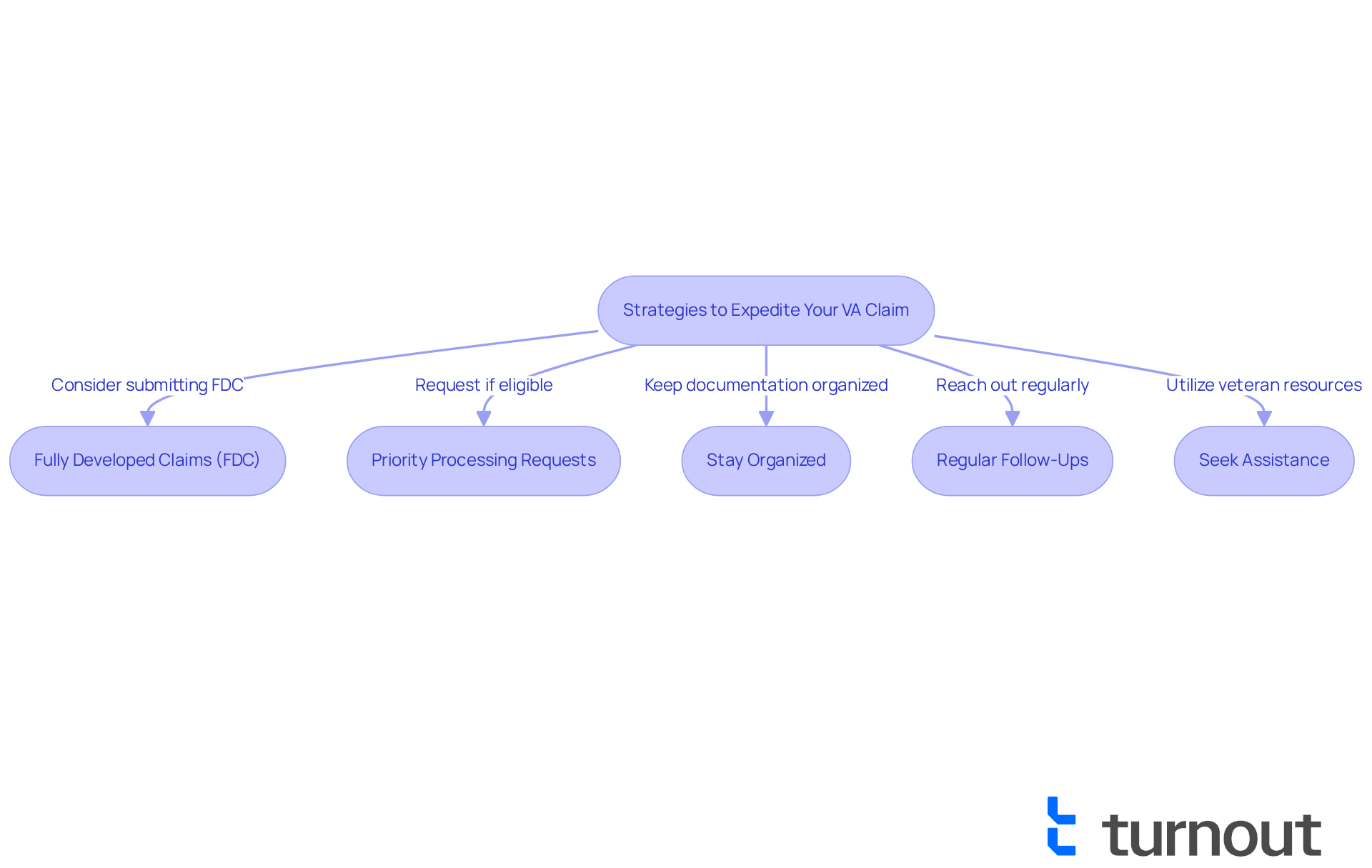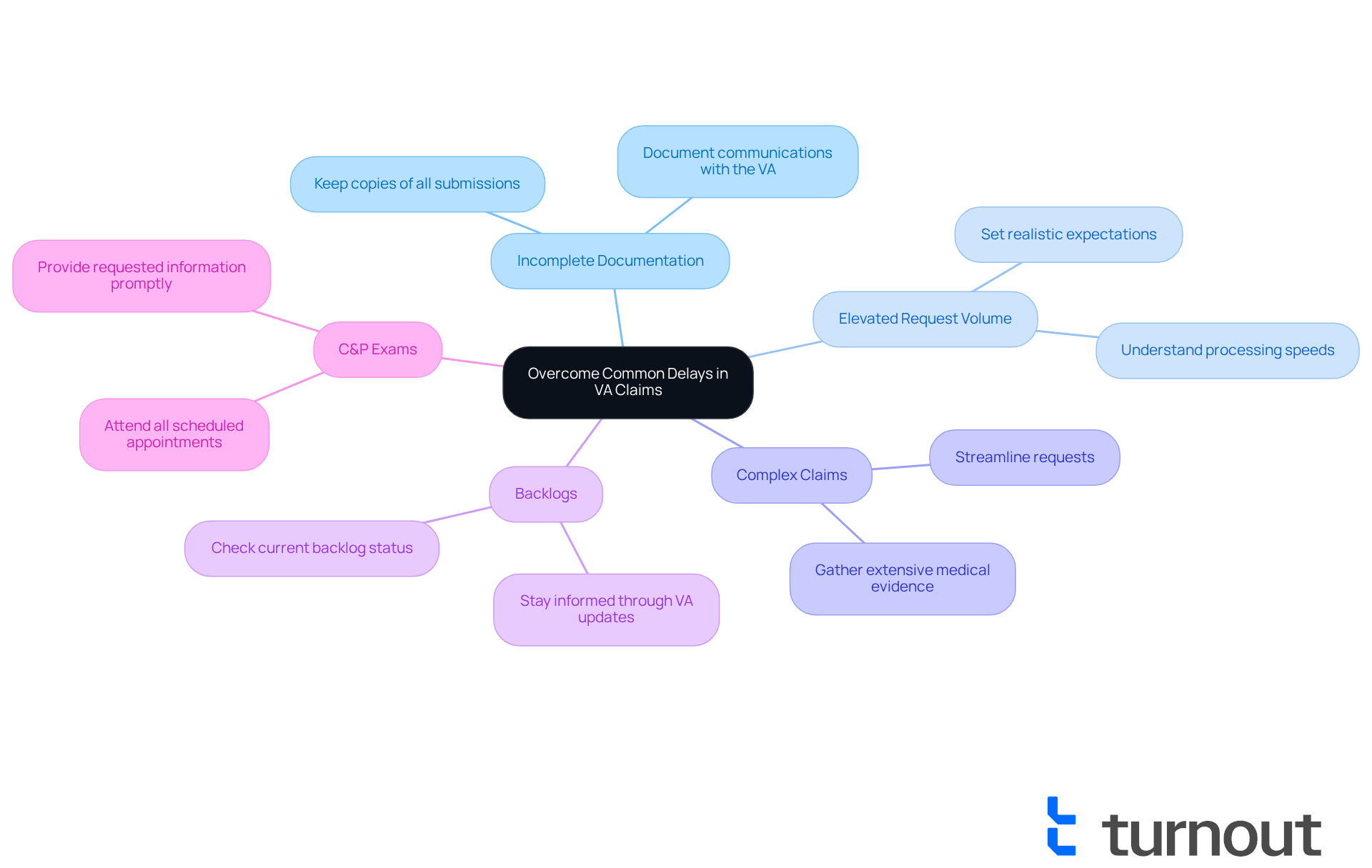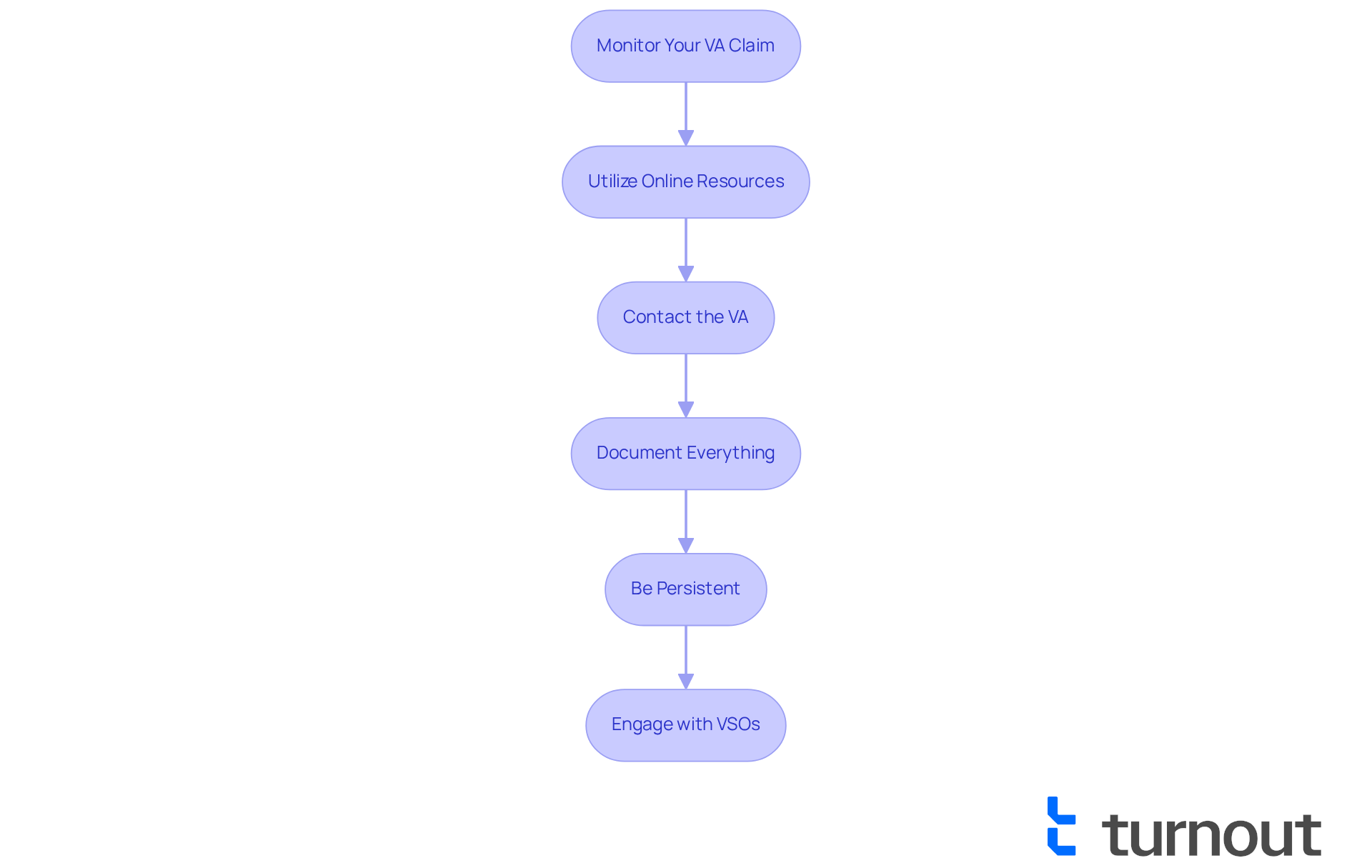Overview
We understand that navigating the VA claim process can be challenging. As of June 2025, the average processing time has improved to 107.4 days, reflecting the VA's dedication to enhancing efficiency. This positive change is supported by a detailed breakdown of the various stages involved, including evidence collection and rating decisions.
It's common to feel overwhelmed, but rest assured, the VA is committed to accuracy in handling claims. We're here to help you through this journey, ensuring that you receive the support you deserve. Remember, you are not alone in this process.
Introduction
Navigating the complexities of the VA claim process can feel overwhelming for many veterans seeking the benefits they truly deserve. We understand that this journey can be fraught with challenges, but grasping the intricacies of this system not only empowers you but also significantly enhances your chances of a successful outcome.
With recent improvements in processing times and accuracy, it’s common to wonder: what truly influences the duration of a VA claim? This article will guide you through the essential steps of the claim process, offer supportive strategies to expedite your requests, and highlight common pitfalls to avoid.
Together, we can ensure that you are well-equipped to tackle your claims efficiently and confidently.
Understand the VA Claim Process
Navigating the can feel overwhelming, but understanding the can make it more manageable:
- Filing Your Request: Begin by submitting your request through the VA website or by mail. Make sure to use the correct forms, such as VA Form 21-526EZ for . We're here to help you through this step.
- Submission Acknowledged: After you send your request, the VA will provide a confirmation letter indicating that it has been received. This usually happens within a week, giving you peace of mind.
- Initial Review: The VA will conduct an initial review to ensure all necessary information is included. If your request is incomplete, it may be postponed, but don’t worry; this is a common part of the process.
- Evidence Collection: The VA will gather relevant medical and service records to support your request. This step can take some time, especially if records are challenging to obtain, but it’s crucial for your claim.
- Rating Decision: Once all evidence is collected, the VA will evaluate your request and assign a based on the severity of your condition. This is a significant moment in your journey.
- Notification: You will receive a decision letter detailing the outcome of your request, including your [disability rating](https://news.va.gov/press-room/va-processes-more-than-2m-disability-claims-in-record-time) and any benefits granted. This letter is an important step toward receiving the .
By understanding these stages, veterans can better anticipate how long does a VA claim take and prepare for each step of the process. As of June 2025, the , which relates to how long does a VA claim take, has improved to 131.8 days, down from 141.5 days earlier this year. This reflects the VA's commitment to enhancing processing times. With over 2 million requests handled in fiscal year 2025—achieved more than a month ahead of the previous record—veterans can look forward to a more efficient system and quicker access to the benefits they need. Furthermore, the VA's accuracy rate for applications has risen to over 92%, improving the reliability of the process. Remember, you are not alone in this journey; support is available every step of the way.
 — follow the arrows from filing your request all the way to receiving your decision letter.](https://images.tely.ai/telyai/kivyrkvv-38-da-8-f-38-7-ca-8-4-cb-0-8-da-2-722468-acef-11.webp)
Implement Strategies to Expedite Your Claim
To expedite your , we understand that navigating the process and knowing how long does a VA claim take can feel overwhelming. Here are some strategies that may help you find a smoother path:
- (FDC): Consider submitting a Fully Developed Claim, which includes all required evidence at the time of filing. This approach can significantly decrease review times. In 2025, the , achieving this milestone nearly two weeks quicker than the prior year. This highlights the efficiency of FDCs.
- : If you qualify under specific criteria, such as or homelessness, you can request priority processing using VA Form 20-10207. This can speed up your request's timeline, especially in urgent circumstances, which makes one wonder how long does a VA claim take. Remember, your needs are important.
- : Keeping all documentation organized and readily accessible is crucial. This includes medical records, service records, and any communication with the VA. A structured approach can enhance the review procedure and help you avoid unnecessary delays.
- Regular Follow-Ups: It’s common to feel anxious about your application’s status. Consistently reaching out to the VA can confirm that your application is being handled effectively. This proactive approach may prompt quicker action if there are any delays.
- Seek Assistance: You are not alone in this journey. Utilize resources such as (VSOs) that provide guidance and support throughout the application process. These organizations can offer valuable insights and help you navigate the complexities of the VA system.
By employing these strategies, you can improve your odds of obtaining a prompt and positive outcome on your requests, especially when considering how long does a VA claim take. With the and an accuracy rate surpassing 92%, implementing these measures can make a notable difference in your experience. As VA Secretary Doug Collins mentioned, "VA’s processing productivity is the , and we look forward to continuing to deliver record levels of service to Veterans and VA beneficiaries.

Overcome Common Delays in VA Claims
Navigating can be challenging, and common delays can arise from several factors that you should be aware of:
- Incomplete Documentation: It’s essential to ensure that all necessary documents accompany your request. . and documenting communications with the VA is crucial to avoid further complications.
- Elevated Request Volume: We understand that the VA frequently encounters substantial numbers of requests, which can impact handling times. In fiscal year 2025, the VA processed a , improving processing speed by 17.8% compared to the previous year. Being aware of can help you set realistic expectations.
- Complex Claims: Claims involving multiple disabilities or extensive medical evidence may take longer to process. If possible, how long does a VA claim take during the review.
- Backlogs: It's important to be aware of the current at the VA, as it can influence how long does a VA claim take. The number of pending requests significantly reduced from almost 1.1 million in 2023 to 154,873 in 2025, suggesting enhancements in the system. Regularly checking for updates on the VA's website can keep you informed.
- C&P Exams: Delays in arranging can also hinder the process. Ensure you attend all scheduled appointments and provide any requested information promptly. Missing an appointment might result in delays or even rejection of your request due to 'failure to cooperate.'
By acknowledging these frequent setbacks, you can take proactive measures to lessen their effect on your application process. Staying organized and engaged throughout the waiting period can help ensure a smoother experience. Remember, you are not alone in this journey, and we’re here to help you every step of the way.

Monitor Your Claim Progress and Communicate Effectively
To effectively and communicate with the VA, consider the following :
- Utilize Online Resources: We understand that keeping track of your claim can be stressful. Make use of the VA's online status tool to . This resource offers real-time updates, helping you stay informed and at ease.
- Contact the VA: If you have questions or concerns, reaching out to the VA's benefits hotline is a good option. Be prepared with your reference number and specific questions to enable a fruitful discussion. As of June 2025, the typical duration for disability claims, specifically , was reported at 107.4 days, reflecting .
- : It’s common to feel overwhelmed during this process. Maintain a detailed record of all communications with the VA, including dates, times, and the names of representatives you speak with. This documentation can be invaluable if issues arise later in your journey.
- : If you encounter delays or complications, remember that following up regularly can make a difference. Many have found that determination leads to faster solutions. As Coleman Nee, National Commander, wisely stated, "While speed is important, accuracy and fairness remain paramount."
- Engage with VSOs: Consider collaborating with a (VSO) for additional support. VSOs can facilitate communication with the VA and offer valuable advice throughout your application process. They provide materials that help manage the intricacies of the application procedure more efficiently.
By actively overseeing your request and communicating effectively, you can help ensure a smoother process and reduce the likelihood of delays. Many veterans, including Dave Riley, have shared their experiences, emphasizing the importance of in navigating the complexities of the VA claims system. Remember, you are not alone in this journey—we're here to help.

Conclusion
Understanding the intricacies of the VA claim process can feel overwhelming for many veterans seeking benefits. We recognize the challenges you face, and by familiarizing yourself with the stages involved—from filing a request to receiving a decision letter—you can navigate this system with greater confidence and clarity. The recent improvements in processing times and accuracy reflect the VA's commitment to enhancing your experience as someone who has served.
To expedite your claims, consider:
- Submitting Fully Developed Claims
- Keeping your documentation organized
- Utilizing resources like veteran service organizations for support
It's common to encounter delays, such as incomplete documentation or high request volumes, but recognizing these obstacles empowers you to take proactive steps in managing your claims efficiently. By staying informed and engaged, you can significantly improve your chances of a timely and favorable outcome.
Ultimately, the journey through the VA claim process may seem daunting, but remember, you are not alone. Support is available. By leveraging the insights and strategies outlined here, you can navigate this path more effectively, ensuring you receive the benefits you rightfully deserve. Taking action now not only aids in your personal claims but also contributes to a broader movement toward a more efficient and responsive VA system. We're here to help you every step of the way.
Frequently Asked Questions
What is the first step in the VA claim process?
The first step is to submit your request through the VA website or by mail, using the correct forms such as VA Form 21-526EZ for disability compensation.
How will I know if my request has been received by the VA?
After you submit your request, the VA will provide a confirmation letter indicating that it has been received, usually within a week.
What happens during the initial review of my claim?
During the initial review, the VA checks to ensure all necessary information is included. If your request is incomplete, it may be postponed.
What is involved in the evidence collection stage?
The VA will gather relevant medical and service records to support your request, which can take time, especially if records are difficult to obtain.
How does the VA determine my disability rating?
After collecting all evidence, the VA evaluates your request and assigns a disability rating based on the severity of your condition.
What will I receive after the VA makes a decision on my claim?
You will receive a decision letter detailing the outcome of your request, including your disability rating and any benefits granted.
How long does it typically take to finalize a VA disability application?
As of June 2025, the average time to finalize a disability application is 131.8 days, an improvement from 141.5 days earlier that year.
How many requests did the VA handle in fiscal year 2025?
The VA handled over 2 million requests in fiscal year 2025, achieving this milestone more than a month ahead of the previous record.
What is the accuracy rate for VA applications?
The VA's accuracy rate for applications has risen to over 92%, improving the reliability of the claims process.
Is support available throughout the VA claim process?
Yes, support is available at every step of the journey to help veterans navigate the claim process.




